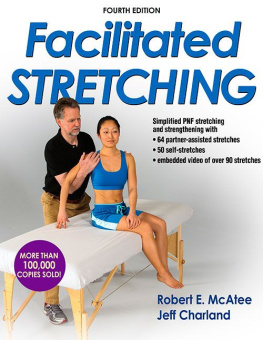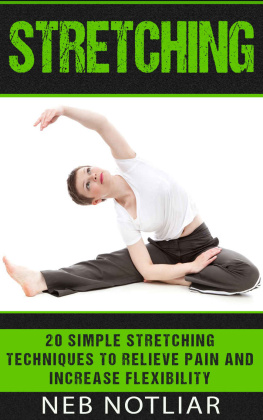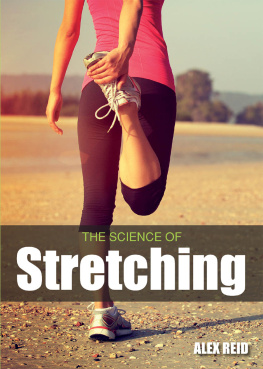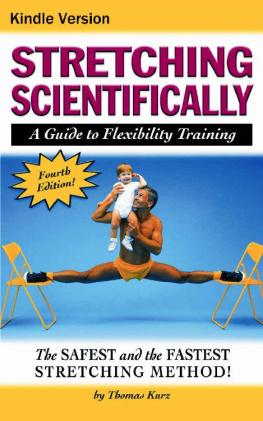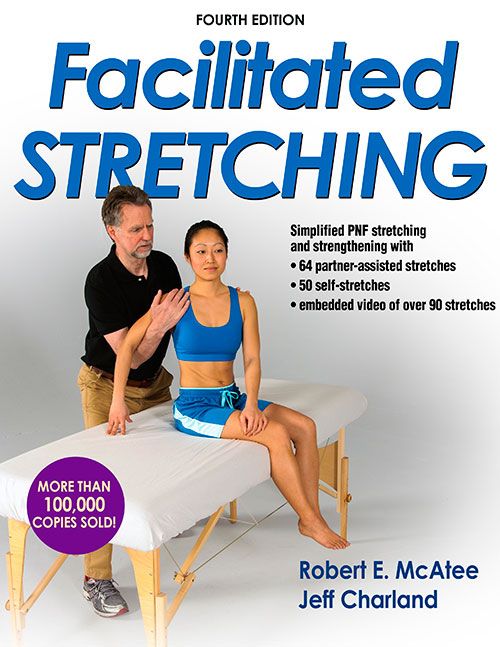
Facilitated Stretching
Fourth Edition
Robert E. McAtee
Jeff Charland

Human Kinetics
Library of Congress Cataloging-in-Publication Data
McAtee, Robert E., 1948- author.
Facilitated stretching / Robert E. McAtee, Jeff Charland. -- Fourth edition.
p. ; cm.
Includes bibliographical references and index.
I. Charland, Jeff, author. II. Title.
[DNLM: 1. Muscle Stretching Exercises--methods. WB 541]
RA781.63
613.7'1--dc23
2013018296
ISBN-10: 1-4504-3431-2 (print)
ISBN-13: 978-1-4504-3431-7 (print)
Copyright 2014, 2007, 1999, 1993by Robert E. McAtee
All rights reserved. Except for use in a review, the reproduction or utilization of this work in any form or by any electronic, mechanical, or other means, now known or hereafter invented, including xerography, photocopying, and recording, and in any information storage and retrieval system, is forbidden without the written permission of the publisher.
The web addresses cited in this text were current as of April 2013, unless otherwise noted.
Acquisitions Editors: Loarn D. Robertson, PhD, Michelle Maloney, and Amy N. Tocco
Developmental Editor: Amanda S. Ewing
Assistant Editor: Casey A. Gentis
Copyeditor: Patricia L. MacDonald
Indexer: Andrea J. Hepner
Permissions Manager: Dalene Reeder
Graphic Designer: Nancy Rasmus
Graphic Artist: Kathleen Boudreau-Fuoss
Cover Designer: Keith Blomberg
Photographer (cover): Neil Bernstein; photograph Human Kinetics
Photographer (interior): Neil Bernstein; photographs Human Kinetics
Photo Asset Manager: Laura Fitch
Visual Production Assistant: Joyce Brumfield
Photo Production Manager: Jason Allen
Art Manager: Kelly Hendren
Associate Art Manager: Alan L. Wilborn
Illustrations: Human Kinetics, unless otherwise noted
Printer: Versa Press
We thank Comcast Studio and Parkland College in Champaign, Illinois, for assistance in providing the location for the photo shoot for this book.
The video contents of this product are licensed for private home use and traditional, face-to-face classroom instruction only. For public performance licensing, please contact a sales representative at www.HumanKinetics.com/SalesRepresentatives.
Printed in the United States of America
10 9 8 7 6 5 4 3 2 1
The paper in this book is certified under a sustainable forestry program.
Human Kinetics
Website: www.HumanKinetics.com
United States: Human Kinetics
P.O. Box 5076
Champaign, IL 61825-5076
800-747-4457
e-mail: humank@hkusa.com
Canada: Human Kinetics
475 Devonshire Road Unit 100
Windsor, ON N8Y 2L5
800-465-7301 (in Canada only)
e-mail: info@hkcanada.com
Europe: Human Kinetics
107 Bradford Road
Stanningley
Leeds LS28 6AT, United Kingdom
+44 (0) 113 255 5665
e-mail: hk@hkeurope.com
Australia: Human Kinetics
57A Price Avenue
Lower Mitcham, South Australia 5062
08 8372 0999
e-mail: info@hkaustralia.com
New Zealand: Human Kinetics
P.O. Box 80
Torrens Park, South Australia 5062
0800 222 062
e-mail: info@hknewzealand.com
E5767
To my wife, Trina, who lovingly encouraged me to write, even at the expense of time we could have spent together.
Contents
Preface
Welcome to the fourth edition of Facilitated Stretching, marking its 20th anniversary by converting to full-color photos and illustrations throughout. We appreciate the support of our 100,000-plus readers who have continued to offer feedback about how to make the book more useful for therapists, trainers, coaches, and athletes of every stripe and ability level. Whether youre an accomplished athlete or are just beginning a fitness program, youll find that the regular use of facilitated stretching will help you improve your flexibility and coordination, which can help improve the overall enjoyment of your chosen sport. If youre a manual therapist, massage therapist, athletic trainer, personal trainer, sport physician, or coach, youll find valuable information and techniques here for optimizing your athletes flexibility, coordination, and performance.
After reviewing reader feedback, weve refocused this fourth edition to more fully reflect the continued interest in training to optimize function and to acknowledge the burgeoning research on the role of fascia in transmitting the forces generated during stretching through adjacent muscles and connective tissue. To this end, weve grouped the stretches around each joint, with less emphasis on individual muscles.
Youll find more than 20 tables, 50 illustrations, and 250 full-color photographs illustrating the stretches and strengthening exercises. To enhance your understanding, weve added graphic elements to selected photos that show the muscles under the skin. Additionally, stylized arrows are placed on selected stretch photos to aid in visualizing the direction of the isometric or the hold effort for the stretcher and the partner.
Organization
This edition is divided into two parts. Part I has three chapters. Chapter 1 lays the groundwork for understanding the basics of stretching. We explain which soft tissues are being stretched, examine the role of reflexes in stretching, discuss the general guidelines for any type of stretching, and describe a variety of stretching techniques. In chapter 2, we focus on facilitated stretching, discussing the historical development of PNF (proprioceptive neuromuscular facilitation), the evolution of facilitated stretching, and our current understanding of the neurophysiology underlying the effectiveness of facilitated stretching, and we give a detailed description of the application of this technique. In chapter 3, we take an in-depth look at the spiraldiagonal patterns of PNF and how theyre used in a variety of movement activities. We discuss using the patterns as part of dynamic warm-up exercises and how to use them in facilitated stretching to improve flexibility by simultaneously engaging synergistic muscle groups. We also discuss and demonstrate how to incorporate the spiraldiagonal patterns into exercise sessions to optimize your functional training.
In part II we show you, step by step, how to stretch the major muscle groups. In this edition, we feature 64 partner-assisted stretches and 50 self-stretches. In previous versions, weve primarily demonstrated the partner-assisted stretches as performed on a treatment table. This time weve added new photographs and descriptions to demonstrate many of the stretches in nontherapy settings (e.g., on an exercise mat, on a workout bench, or in a chair) to show how the stretches can be done in a variety of locationsat home, in a gym, while traveling, and so on.
Chapter 4 covers the torso and neck; chapter 5 focuses on the lower extremity; and chapter 6 details stretches for the upper extremity. Chapter 7 consists of stretching routines for activity. As in previous editions, these routines are for running, golf, swimming, throwing and racket sports, cycling, everyday stretches, and rusty hinges. In response to many requests, weve added a stretching routine for ice hockey.
Weve also added an appendix to the fourth edition that features an overview of the anatomical planes of motion, anatomical terms, and types of joints. This information is useful for readers unfamiliar with these terms and also as a quick review for those who learned it in the past and may feel a bit rusty.

